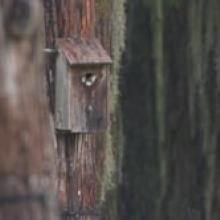

Join BirdNote tomorrow, November 30th!
Illustrator David Sibley and actor H. Jon Benjamin will face off in the bird illustration battle of the century during BirdNote's Year-end Celebration and Auction!
The Wood Duck was once the most abundant duck east of the Mississippi River. But the draining of wetlands, forest fragmentation, and market hunting caused serious declines in their numbers. In 1918, the Migratory Bird Treaty Act banned hunting of Wood Ducks for 23 years. Federal regulation and the concern of dedicated individuals, including Frank Bellrose, brought the duck back. By the 1960s, populations had recovered to three million birds.
BirdNote®
Wood Duck
Written by Todd Peterson
This is BirdNote!
[Call of the Wood Duck]
He is perhaps the most beautiful of all North American ducks. His Latin name means dressed in finery ready for his wedding. But the Wood Duck was once threatened with extinction.
In the 1800s, the Wood Duck was possibly the most abundant duck east of the Mississippi River. But the draining of wetlands, forest fragmentation, [Chain saw sounds] and market hunting caused precipitous declines in their numbers. In 1918, the Migratory Bird Treaty Act completely banned hunting of Wood Ducks for 23 years. Federal regulation and the concern and knowledge of dedicated individuals brought the Wood Duck back. By the 1960s, populations had recovered to three million birds.
[Call of the Wood Duck]
Preeminent among these people was Frank Bellrose. Frank grew to love Wood Ducks while canoeing the Illinois River as a young man in the 1930s.
[Slap of waves against a canoe]
He went on to study them for more than 50 years. His intimate knowledge of the bird’s ecology enabled him to invent the predator-proof nesting box, now a staple of Wood Duck conservation.
We take care of what we value, what we devote ourselves to knowing. And one person’s dedication can make the crucial difference, as it did with Frank Bellrose and the Wood Ducks he loved. I’m Frank Corrado.
[Call of the Wood Duck]
###
Call of the Wood Duck provided by The Macaulay Library of Natural Sounds at the Cornell Lab of Ornithology, Ithaca, New York. Recorded by G.B. Reynard.
Ambient recording R.S. Little and Kessler Productions.
Producer: John Kessler
Executive Producer: Chris Peterson
© 2006 Seattle Audubon © 2008 Tune In to Nature.org
ID# 042706WODUKPLU WODU-01









